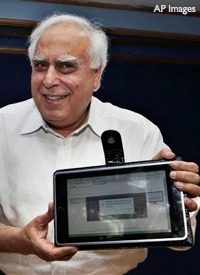
Sibal said that over one-third of the 25,000 colleges and universities across India have upgraded to broadband Internet access, and hundreds of online and video-streaming courses are now available for Indian students, with hundreds more in process. The new computer, Sibal said, will be the vehicle to connect millions of Indian students from primary grades through college to the ever-increasing opportunities.
Designed with the help of students from the Indian Institute of Technology, the computer has a memory card instead of a hard drive, boasts 2GB of RAM, and includes all the functions one would expect in a basic computer, including a Web browser, media player, PDF reader, wireless capability, and video-conferencing. Some “pricier” models will even include a solar-power option for use in areas of India where electricity is scarce.
“This is our answer to MIT’s $100 computer,” boasted Sibal, referring to the prototype laptop for children unveiled in 2005 by Nicholas Negroponte, co-founder of the Massachusetts Institute of Technology’s famed Media Lab. The price of the MIT unit ended up rising to around $200, but Negroponte recently announced that his non-profit group, One Laptop Per Child, is planning to introduce a stripped-down tablet computer for $99.
While the Indian government is hoping that it will eventually be able to drop the price of its own computer to $20 and lower, as of yet there is no firm word as to what software the computer will include, a factor that could end up driving the price higher. In addition, India has yet to find a manufacturer willing to mass-produce the computer for the desired price.
“This is just a prototype,” emphasized Indian education expert Zubin Malhotra. “We need to find people who will be able to manufacture these devices at these price points and continue to develop them going forward.”
While it is the second most populous nation on earth with nearly 1.2 billion people, India has the highest illiteracy rate in the world at nearly 40 percent. The government’s latest computer project is part of its larger goal of raising the education and technical skill levels of its population. No doubt part of the optimism stems from the country’s success over the last several years in putting cheap cell phones into the hands of over 500 million individuals.
The government hopes it can have similar success in fully integrating India’s population into the digital age, crossing over Internet and wireless technology from the urban areas into the country’s more remote regions. For example, the government is working to connect all 250,000 of its villages councils with central government databases in the next two years.
While the prototype computer was unveiled with much fanfare and applause worldwide, informed observers within India remain skeptical of the project’s ultimate success. With materials alone estimated at $47, not to mention manufacturing, manpower, transportation, and other incidental costs, the likelihood of finding a company to produce the machine for $35 initially—and then to drop the price another $15 or more—seems somewhat farfetched to business analysts.
Comparing the government-funded project to the highly successful Apple iPad, the Economic Times of India noted that Apple launched its most recent success story to the tune of “a million units ready to sell, and midnight queues outside,” while the India government introduced its dream with little more than, well, a dream—no solid software plan, no apps, no manufacturer, and, in fact, no blueprint for success.
Explained the Economic Times, “You don’t show prototypes unless they are working ones with running apps, backed by a clear game plan to build up a vendor and apps network, and a clear design and specifications—and, preferably, a bill of materials.”
There is also the issues, noted the paper, of “ongoing process, with software updates, improvements, upgrades, and most of all, growing apps support.” Even with the initial success of designing and even producing a working computer, “it’s no trivial task maintaining it through the life cycle of the product, ensuring support, firmware and hardware upgrades, and new versions.” In his press conference, Sibal offered no word on how the government would provide crucial ongoing support to hundreds of millions of computers in the hands of eager students. Such an oversight is a fatal flaw in the plan.
In short, India’s ambitious $35 computer plan amounts to yet another example of government intrusion into an area that ought to be the exclusive domain of the free market. Cheap computers for the masses is a great idea, and will, no doubt, become a reality—when entrepreneurial individuals and institutions work out all the logistical bugs and can produce and market them at a profit.



